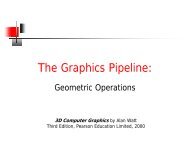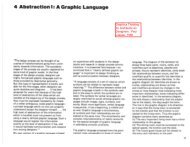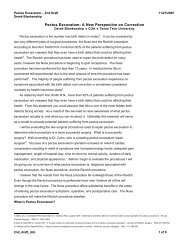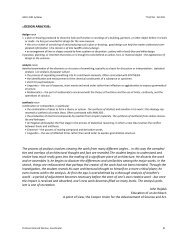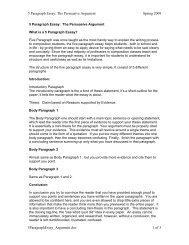The Eyes of the Skin
The Eyes of the Skin
The Eyes of the Skin
You also want an ePaper? Increase the reach of your titles
YUMPU automatically turns print PDFs into web optimized ePapers that Google loves.
in terms <strong>of</strong> vision, emphasising <strong>the</strong> construction <strong>of</strong> three-dimensionalvisual images in space.An Architecture <strong>of</strong> Visual Images<strong>The</strong> ocular bias has never been more apparent in <strong>the</strong> art <strong>of</strong> architecturethan in <strong>the</strong> past 30 years, as a type <strong>of</strong> architecture, aimed at a striking andmemorable visual image, has predominated. Instead <strong>of</strong> an existentiallygrounded plastic and spatial experience, architecture has adopted <strong>the</strong> psychologicalstrategy <strong>of</strong> advertising and instant persuasion; buildings haveturned into image products detached from existential depth and sincerity.David Harvey relates '<strong>the</strong> loss <strong>of</strong> temporality and <strong>the</strong> search forinstantaneous impact' in contemporary expression to <strong>the</strong> loss <strong>of</strong> experientialdepth. 58FredricJameson uses <strong>the</strong> notion <strong>of</strong> 'contrived depthlessness'to describe <strong>the</strong> contemporary cultural condition and 'its fIxationwith appearances, surfaces and instant impacts that have no sustainingpower over time'.59As a consequence <strong>of</strong> <strong>the</strong> current deluge <strong>of</strong> images, architecture <strong>of</strong>our time <strong>of</strong>ten appears as mere retinal art <strong>of</strong> <strong>the</strong> eye, thus completingan epistemological cycle that began in Greek thought and architecture.But <strong>the</strong> change goes beyond mere visual dominance; instead <strong>of</strong> being asituational bodily encounter, architecture has become an art <strong>of</strong> <strong>the</strong>printed image fIxed by <strong>the</strong> hurried eye <strong>of</strong> <strong>the</strong> camera. In our culture <strong>of</strong>pictures, <strong>the</strong> gaze itself flattens into a picture and loses its plasticity.Instead <strong>of</strong> experiencing our being in <strong>the</strong> world, we behold it from outsideas spectators <strong>of</strong> images projected on <strong>the</strong> surface <strong>of</strong> <strong>the</strong> retina.David Michael Levin uses <strong>the</strong> term 'frontal ontology' to describe <strong>the</strong>prevailing frontal, fIxated and focused vision.6oSusan Sontag has made perceptive remarks on <strong>the</strong> role <strong>of</strong> <strong>the</strong> photographedimage in our perception <strong>of</strong> <strong>the</strong> world. She writes, for instance,<strong>of</strong> a 'mentality which looks at <strong>the</strong> world as a set <strong>of</strong> potential photographs',61and argues that '<strong>the</strong> reality has come to seem more and morewhat we are shown by camera',62 and that '<strong>the</strong> omnipresence<strong>of</strong> photographshas an incalculable effect on our ethical sensibility. By furnishingthis already crowded world with a duplicate one <strong>of</strong> images, photographymakes us feel that <strong>the</strong> world is more available than it really is.'63As buildings lose <strong>the</strong>ir plasticity, and <strong>the</strong>ir connectionwith <strong>the</strong> languageand wisdom <strong>of</strong> <strong>the</strong> body, <strong>the</strong>y become isolated in <strong>the</strong> cool anddistant realm <strong>of</strong> vision. With <strong>the</strong> loss <strong>of</strong> tactility, measures and detailscrafted for <strong>the</strong> human body - and particularlyfor <strong>the</strong> hand - architecturalstructures become repulsively flat, sharp-edged, immaterial andunreal. <strong>The</strong> detachment <strong>of</strong> construction from <strong>the</strong> realities <strong>of</strong> matterand craft fur<strong>the</strong>r turns architecture into stage sets for <strong>the</strong> eye, into ascenography devoid <strong>of</strong> <strong>the</strong> au<strong>the</strong>nticity <strong>of</strong> matter and construction.<strong>The</strong> sense <strong>of</strong> 'aura', <strong>the</strong> authority <strong>of</strong> presence, that Walter Benjaminregards as a necessary quality for an au<strong>the</strong>ntic piece <strong>of</strong> art, has beenlost. <strong>The</strong>se products <strong>of</strong> instrumentalised technology conceal <strong>the</strong>irprocesses <strong>of</strong> construction, appearing as ghostlike apparitions. <strong>The</strong>increasing use <strong>of</strong> reflective glass in architecture reinforces <strong>the</strong> dreamlikesense <strong>of</strong> unreality and alienation. <strong>The</strong> contradictory opaque transparency<strong>of</strong> <strong>the</strong>se buildings reflects <strong>the</strong> gaze back unaffected andunmoved; we are unable to see or imagine life behind <strong>the</strong>se walls. <strong>The</strong>architecturalenigmatic and frighteningMaterialitymirror, that returns our gaze and doubles <strong>the</strong> world, is anand Timedevice.<strong>The</strong> flatness <strong>of</strong> today's standard construction is streng<strong>the</strong>ned by a weakenedsense <strong>of</strong> materiality. Natural materials - stone, brick and wood allow our vision to penetrate<strong>the</strong>ir surfaces and enable us to become convinced<strong>of</strong> <strong>the</strong> veracity <strong>of</strong> matter. Natural materials express <strong>the</strong>ir age andhistory, as well as <strong>the</strong> story <strong>of</strong> <strong>the</strong>ir origins and <strong>the</strong>ir history <strong>of</strong> humanuse. All matter exists in <strong>the</strong> continuum<strong>of</strong> time; <strong>the</strong> patina <strong>of</strong> wear adds<strong>the</strong> enriching experience <strong>of</strong> time to <strong>the</strong> materials <strong>of</strong> construction.But <strong>the</strong>30THE EYES OFTHE SKINPART I 31






